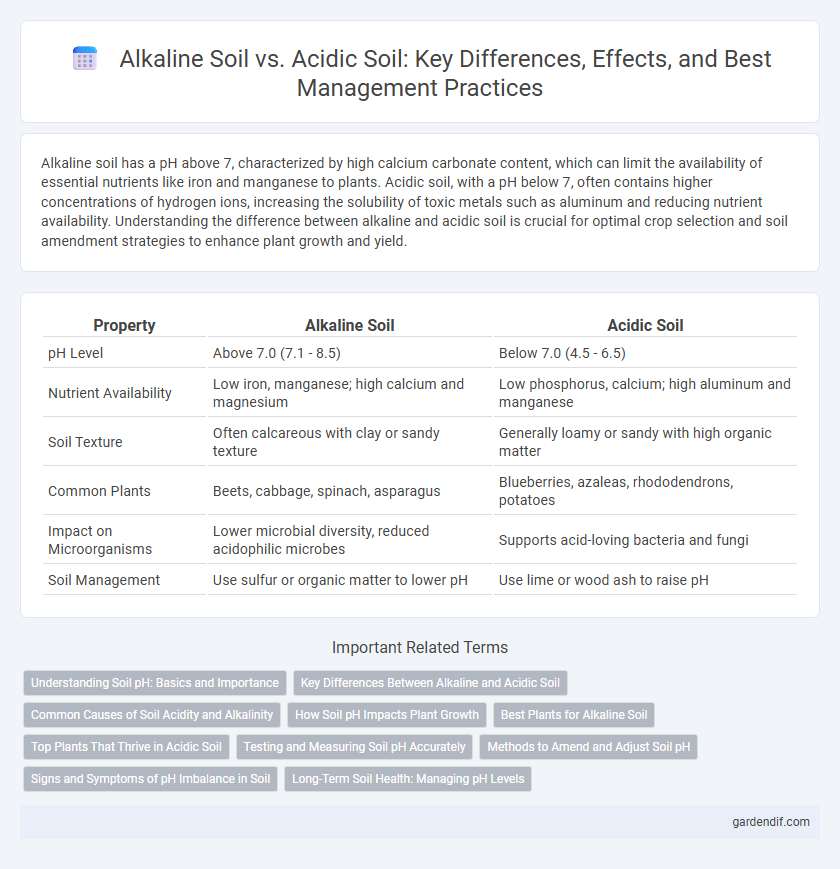
Alkaline Soil vs Acidic Soil Illustration
Alkaline soil has a pH above 7, characterized by high calcium carbonate content, which can limit the availability of essential nutrients like iron and manganese to plants. Acidic soil, with a pH below 7, often contains higher concentrations of hydrogen ions, increasing the solubility of toxic metals such as aluminum and reducing nutrient availability. Understanding the difference between alkaline and acidic soil is crucial for optimal crop selection and soil amendment strategies to enhance plant growth and yield.
Table of Comparison
| Property | Alkaline Soil | Acidic Soil |
|---|---|---|
| pH Level | Above 7.0 (7.1 - 8.5) | Below 7.0 (4.5 - 6.5) |
| Nutrient Availability | Low iron, manganese; high calcium and magnesium | Low phosphorus, calcium; high aluminum and manganese |
| Soil Texture | Often calcareous with clay or sandy texture | Generally loamy or sandy with high organic matter |
| Common Plants | Beets, cabbage, spinach, asparagus | Blueberries, azaleas, rhododendrons, potatoes |
| Impact on Microorganisms | Lower microbial diversity, reduced acidophilic microbes | Supports acid-loving bacteria and fungi |
| Soil Management | Use sulfur or organic matter to lower pH | Use lime or wood ash to raise pH |
Understanding Soil pH: Basics and Importance
Soil pH is a critical factor influencing nutrient availability and microbial activity, with alkaline soils typically having a pH above 7 and acidic soils below 7. Alkaline soils often contain higher levels of calcium carbonate, which can limit the availability of essential micronutrients like iron and manganese. Acidic soils, common in regions with high rainfall, increase the solubility of toxic metals like aluminum, affecting root growth and overall plant health.
Key Differences Between Alkaline and Acidic Soil
Alkaline soil has a pH above 7, with high calcium carbonate content, while acidic soil has a pH below 7, often rich in organic matter and aluminum ions. Nutrient availability varies significantly; alkaline soils tend to limit iron, manganese, and phosphorus uptake, whereas acidic soils can restrict calcium, magnesium, and molybdenum absorption. These pH differences influence microbial activity, plant growth, and suitability for various crop types, making pH adjustment critical for optimal soil management.
Common Causes of Soil Acidity and Alkalinity
Soil acidity commonly results from factors such as heavy rainfall leaching away basic ions like calcium and magnesium, the decomposition of organic matter releasing organic acids, and the application of nitrogen-based fertilizers that produce acidic residues. Alkaline soil typically forms in arid or semi-arid regions where low rainfall limits leaching, causing the accumulation of basic ions such as calcium carbonate and magnesium carbonate. Human activities like lime application increase soil pH, while acid rain and excessive use of ammonium fertilizers contribute to soil acidification.
How Soil pH Impacts Plant Growth
Soil pH significantly influences nutrient availability, affecting plant growth and development. Alkaline soil, with a pH above 7, can cause deficiencies in iron, manganese, and phosphorus, leading to poor plant health. Acidic soil, with a pH below 7, often limits calcium and magnesium uptake but increases availability of aluminum and manganese, which can be toxic in high concentrations.
Best Plants for Alkaline Soil
Best plants for alkaline soil include lavender, clematis, and lilac, which thrive in pH levels above 7.0. These plants efficiently absorb nutrients in high-pH environments, promoting healthier growth and vibrant blooms. Choosing species suited for alkaline soil improves garden success and reduces nutrient deficiency issues.
Top Plants That Thrive in Acidic Soil
Azaleas, blueberries, and rhododendrons are top plants that thrive in acidic soil with a pH level below 7. Acidic soil promotes the availability of essential nutrients like iron and manganese, supporting these plants' vibrant blooms and healthy growth. Gardeners often amend soil with sulfur or organic matter to maintain the ideal acidic conditions for these species.
Testing and Measuring Soil pH Accurately
Testing soil pH involves using a reliable pH meter or pH test kit to obtain accurate measurements, essential for distinguishing alkaline soil (pH above 7) from acidic soil (pH below 7). Ensuring representative soil samples from multiple locations and depths improves test accuracy, reflecting true soil conditions for optimal plant growth. Regular monitoring of soil pH enables precise adjustments through lime application for acidic soils or sulfur amendments for alkaline soils to maintain balanced nutrient availability.
Methods to Amend and Adjust Soil pH
Alkaline soil with a pH above 7 can be amended by incorporating elemental sulfur or organic matter such as peat moss to lower pH and increase acidity. Acidic soil with a pH below 7 can be adjusted by adding lime materials like calcitic lime or dolomitic lime to raise pH and reduce acidity. Regular soil testing ensures precise pH balance, optimizing nutrient availability and promoting healthy plant growth.
Signs and Symptoms of pH Imbalance in Soil
Alkaline soil often exhibits symptoms such as yellowing leaves (chlorosis) due to nutrient deficiencies in iron, manganese, and phosphorus, while acidic soil may show stunted plant growth and poor root development caused by aluminum toxicity and lack of essential nutrients like calcium and magnesium. Signs of pH imbalance also include uneven crop yields and visible nutrient deficiencies that vary depending on the plant species affected. Soil pH testing and observing plant health indicators are critical for diagnosing and correcting these imbalances to optimize soil fertility and crop productivity.
Long-Term Soil Health: Managing pH Levels
Maintaining balanced pH levels is crucial for long-term soil health, as alkaline soil with pH above 7 often causes nutrient lockout, limiting availability of essential minerals like iron and phosphorus. Acidic soil below pH 7 can lead to toxic aluminum and manganese concentrations, harming plant roots while reducing microbial activity necessary for soil fertility. Regular soil testing combined with amendments such as lime to raise pH in acidic soil or sulfur to lower pH in alkaline conditions ensures optimal nutrient cycling and sustainable crop productivity.
Alkaline Soil vs Acidic Soil Infographic

 gardendif.com
gardendif.com